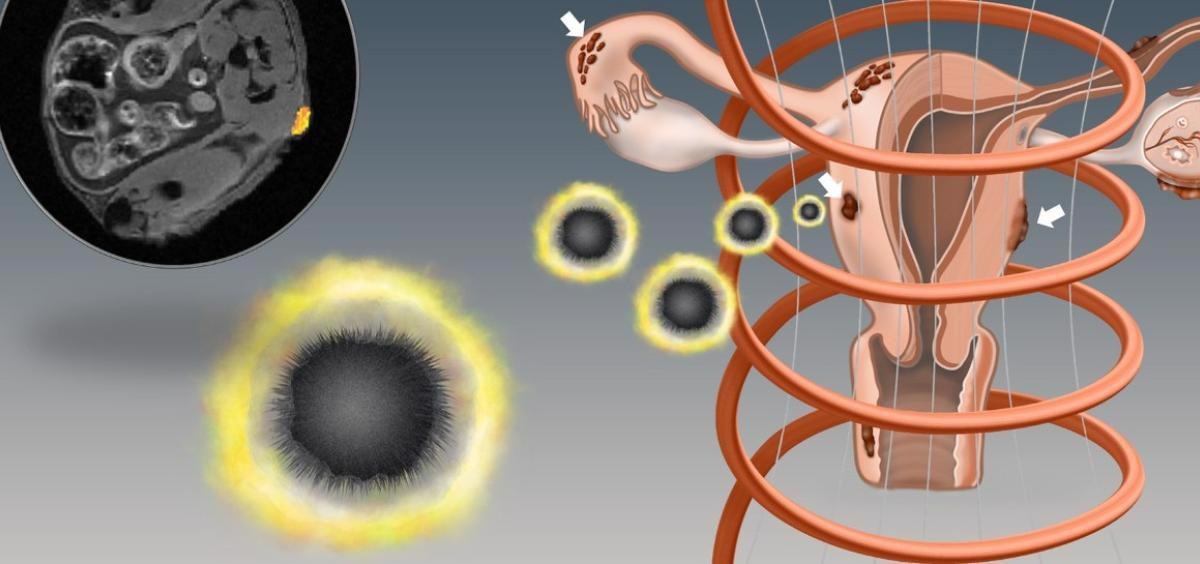Researchers have formulated a new nanotechnology method for finding and removing painful and unsafe lesions related to endometriosis, a widely prevalent gynecological disorder in women of childbearing age.

Image Credit: Parinaz Ghanbari, Oregon State University
Directed by Oleh Taratula of the Oregon State University’s College of Pharmacy and Ov Slayden of the Oregon National Primate Research Center at Oregon Health & Science University, the study encompasses magnetic nanoparticles – minute pieces of matter measuring as small as one-billionth of a meter.
Reported recently in the journal Small, the animal-model study demonstrates that the iron oxide nanoparticles when injected intravenously behave as a contrast agent – they amass in the lesions, rendering them easier to view using advanced imaging like MRI.
Moreover, when exhibited under an alternating magnetic field, a non-invasive process, the temperature of the nanoparticles rises to over 120°F, which is sufficiently high for lesion removal via heat.
Endometriosis is a debilitating, systemic disease, and the need for an efficient, non-surgical method of removing the lesions is urgent. We invented targeted nanoparticles with extraordinary heating capabilities that enable the use of magnetic hyperthermia for the safe and efficient elimination of endometriosis lesions.
Oleh Taratula, Study Lead, College of Pharmacy, Oregon State University
The endometrium is the uterus’ innermost layer, and endometriosis happens when endometrium-like tissue develops lesions on the outer side of the uterine cavity – typically involving the fallopian tubes, the ovaries, and the tissue lining the pelvis.
In the rarest cases, endometrial tissue could even grow beyond the pelvic area.
According to the World Health Organization (WHO), approximately 10% of childbearing-age women will go through endometriosis, and 35% to 50% of women with infertility and/or pelvic pain suffer from the disorder. The WHO also reports that endometriosis impacts about 190 million women worldwide.
Endometriosis cannot be cured, although surgical extraction of the lesions can enhance fertility. The disadvantage, however, is that the lesions return in half the cases, and over one-quarter of endometriosis surgery patients need three or more surgeries as it is tough to locate all of the unhealthy tissue that needs to be extracted.
Endometriosis is a non-malignant condition, but the lesions sometimes perforate organs, resulting in a life-threatening situation. Therapies for pain result in infertility, and patients wishing to improve fertility often seek surgical removal of the lesions. And unfortunately, not only is the recurrence rate high, complications associated with surgery add to the overall risk.
Olena Taratula, Research, College of Pharmacy, Oregon State University
Magnetic hyperthermia had not formerly been thought of as a potential method of ablating endometriosis lesions since other magnetic nanoparticles have comparatively low heating efficiency, she explained. The nanoparticles could only become sufficiently hot after being directly injected into unhealthy tissue, which is not an accurate method for endometriosis.
The partnership that also included Abraham Moses, Peter Do Youngrong Park, and Ananiya Demessie from the College of Pharmacy surpassed that issue by creating hexagonal-shaped nanoparticles that have over six times the heating efficiency of traditional spherical nanoparticles when exposed to an alternating magnetic field.
Adjusting the nanoparticles with a peptide – many amino acids connected in a chain – that targets a cellular receptor copious in endometriosis cells improved their ability to amass in endometriosis lesions, the researchers stated. Experiments conducted on mice with endometriotic tissue transplanted from macaques showed the ability of the nanoparticles to eliminate the diseased cells after a single session of magnetic hyperthermia.
Furthermore, in collaboration with Khashayar Farsad from OHSU’s Dotter Interventional Institute, we showed the efficiency of the same nanoparticles as an MRI contrast agent. This feature of the nanoparticles can aid in the diagnosis of endometriotic lesions by MRI before their exposure to the external alternating magnetic field.
Oleh Taratula, Study Lead, College of Pharmacy, Oregon State University
Furthermore, others who were part of the project team include Addie Luo of the Oregon National Primate Research Center; Cory Wyatt of the OHSU Department of Diagnostic Radiology; Leonardo Campos and Younes Jahangiri of the Dotter Interventional Institute; Hassan Albarqi of Najran University in Saudi Arabia; and Parinaz Ghanbari, who helped prepare the graphical abstract illustrating the research.
Oleh and Olena Taratula each have an adjunct appointment with OHSU.
The National Institutes of Health, the National Primate Research Center, the Eunice Kennedy Shriver National Institute of Child Health and Human Development, and the OSU College of Pharmacy supported this study.
Journal Reference:
Park, Y., et al. (2022) Targeted Nanoparticles with High Heating Efficiency for the Treatment of Endometriosis with Systemically Delivered Magnetic Hyperthermia. Small. doi.org/10.1002/smll.202107808.